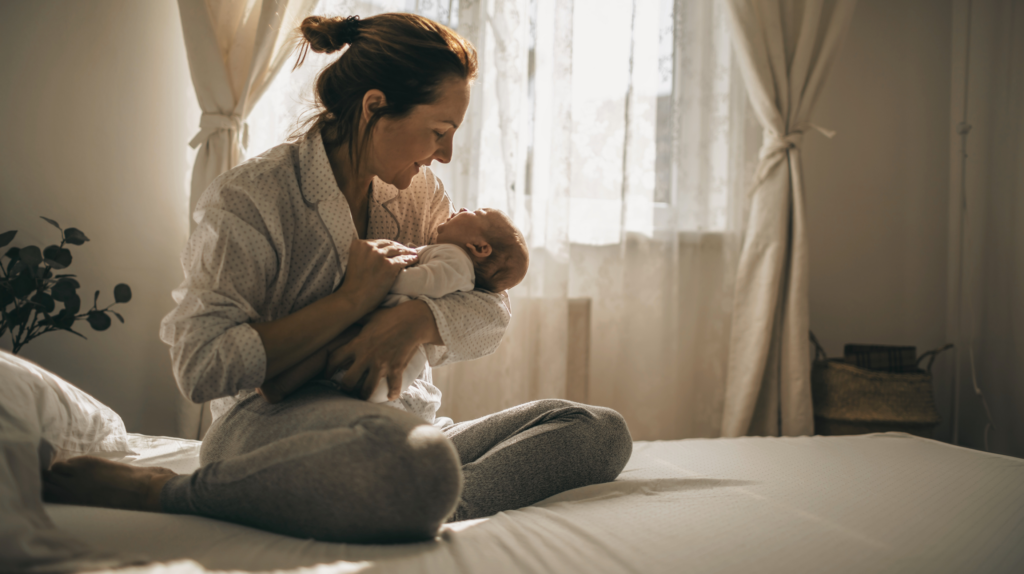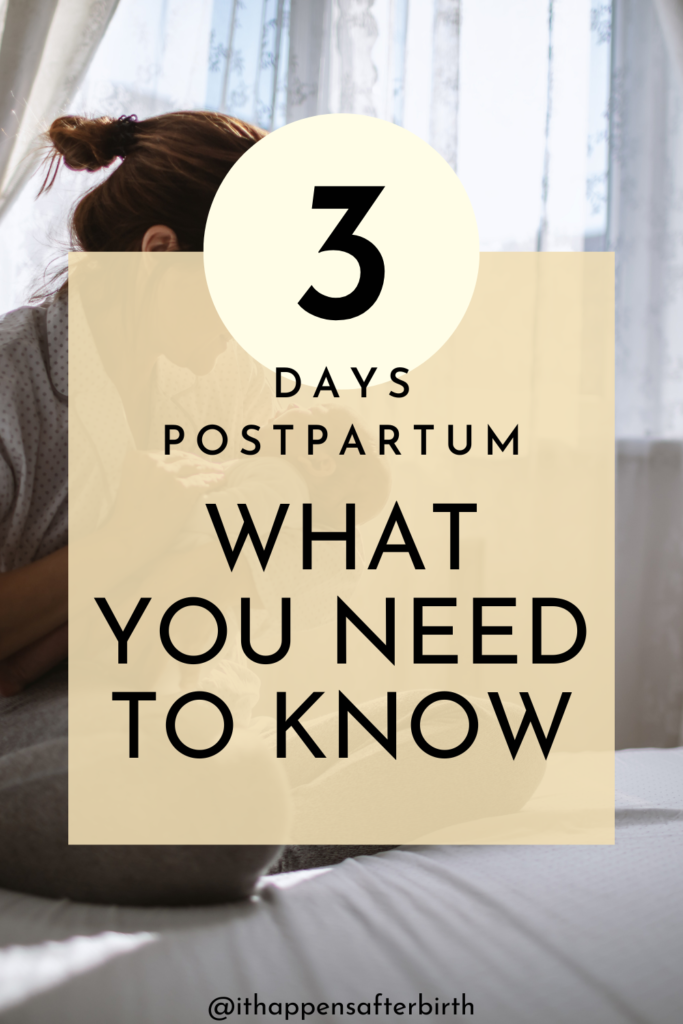This post will cover the first three days after birth and what is happening physically and hormonally with new mothers.

There’s a lot that happens during labor- three very distinct stages, muscles and hormones working to bring your baby to this world, and the emotional fluctuations that we go through. But all of that doesn’t stop after the birth! The physical and emotional changes in your body continue, especially in the first few days.
It can all be a little overwhelming, but even more so if you aren’t quite sure what to expect. You might be wondering if everything you’re feeling is normal or a reason to be concerned. The truth is that “normal” can vary from person to person (never will two people have the exact same experience), but there is a common flow to postpartum women in the first few days after birth. Let’s take a look at what’s going to be going on in these first three days.
Physical changes in the first three days
It took many months for your body to adjust and change during pregnancy, and it’s going to take a while for your body to readjust after birth. In the meantime, a lot of major readjustments are going to start within the first few days.
Uterus
Again, your uterus just spent weeks and weeks growing out, and now it has to shrink back down.
It’ll typically take a full two weeks at least to return to its normal pear-shaped size (a process called involution). This process starts right after the birth of your baby and placenta.
It’s going to start shrinking back down by contracting (yes, the same type of contractions that you just went through for labor). If this is your first birth, you may not feel these contractions, but studies show that “after-birth contractions” tend to get worse with each additional pregnancy and birth. Your uterus will shrink by about 0.4inches/1 cm per day.
Because your uterus is enlarged, you might feel bloated or heavy. But if you start to notice that you feel overly heavy in the vaginal area when you stand up (think like a bowling ball feeling), this could be a sign that something isn’t right and you should check in with your care provider.
Bleeding
The placenta leaves a dinner-plate sized open wound on the wall of your uterus. Your uterus is contracting. Between those events, you’ll be expelling a lot of blood. It’s almost like your body is making up for all those months of not having a period.
The bleeding cycle after birth is called “lochia” and has three stages. The first stage is like a normal period- red blood with some small clots. This will usually last the first few days before starting to change over to brown discharge with lighter bleeding.
This is all normal.
If you’re experiencing intense pain, filling more than one pad every two hours, or starting to pass oversized clots (think golf ball sized or larger), this is NOT normal and you need to get in touch with your care provider right away.
Perineum and Vagina
It’s most likely that after pushing, your vaginal area will be swollen and sore. Typically this will go away after a few days- but it might be a while before you feel comfortable with it again! If swelling lingers for a while, check in with your care provider about possible reasons or solutions.
Tearing is another huge reason for feeling pain and discomfort within the vaginal area. (And the perineum is not the only place you can tear!) You won’t get stitches for tiny tears- instead they’ll be left open until they heal. (Like getting a small cut on your hand.) This is normal, but it can sting in the meantime.
On the perineum, tears are measured in degrees- 1st-degree, 2nd-degree, 3rd-degree, and 4th-degree.
You may or may not get stitches for a 1st-degree tear. It depends on your provider and how big the tear actually is. The rest you will get stitches for.
Typically providers use dissolvable stitches, meaning you won’t have to have them taken out at the 6-week appointment.
Within the first few days after birth, it’s normal to feel a slight tightness or discomfort where the stitches are. Your body is just working on healing, and that area in particular went through a lot. Whether you got stitches or not, your perinuem is going to be very tender and needs to be treated gently.
If you start to feel pain, a poking sensation, see unusual-looking discharge, or notice a foul smell from the vaginal area, this is a sign that something is going on that is not normal. Please contact your provider and ask to be seen.
Urinary System
In the first day or two after birth, your body will likely have an argument with itself over the urinary system.
What do I mean by this?
Because of all the hormonal fluctuations going on, your body will go into diuresis after birth (basically- you’re going to need to get rid of a lot of fluid, so you’re going to urinate a lot). But due to what your vaginal area just went through, you may be physically or mentally unable to pee. Fun, right?
This is actually normal for most women after birth, so it isn’t anything to be concerned about right away. There’s a couple ways you can “trick” your muscles into relaxing enough to let pee out, things like:
- Inhaling the scent of peppermint. (Preferably peppermint essential oil, as it’s stronger and more potent)
- Turning the tap on and listening to the sound of running water as you sit on the toilet
- Sitting in a warm bath. (If it grosses you out to imagine peeing in the water you’re sitting in, I get it! Save it as a last resort).
- Leaning forward slightly while on the toilet can help relax your pelvic floor muscles.
Your care provider will probably want you to use the bathroom within the first few hours after birth. If it gets to be a while and you still haven’t been able to pee, then a catheter is probably the next step to empty your bladder.
It’s not fun
Urinating after birth can be very intimidating and painful. And it might take the full three days (or even more) to feel comfortable with peeing again! The pain comes from the swelling and tears, and while there isn’t much to ease the pain until you’ve healed, using a peri bottle full of warm water while you pee can help with discomfort.
It’s important over these first three days to make sure that you are emptying your bladder fully and often. It is normal to feel some discomfort during bathroom visits in the first few days, but if the pain becomes too much, there’s excessive burning when you pee, or you constantly feel the need to pee, this is not normal and should be talked about with your provider.
Breasts
Your breasts will go through some changes in the first few days too. Even if you’ve made the choice not to breastfeed.
You’ve seen your breasts grow throughout pregnancy, experienced some tenderness, and maybe even seen some other physical changes like stretch marks, bumps around the dark skin surrounding your nipple, or erect nipples.
You will have started to produce colostrum sometime in the second trimester, thought you might not have seen it if you weren’t trying to express milk. The colostrum will remain for the first few days. Around day three postpartum, what’s referred to as “mature milk” will come in.
This could mean many things: enlarged breasts, more frequent feedings, leaking milk, etc. All of these are considered normal.
You’ll want to watch out for some signs that might show something abnormal going on, like warmth, redness, or pain within the breast, or fever and chills. (Note: nipple pain is common around this time and usually means the latch needs to be adjusted; if that’s the only place you feel pain, look at the latch first.) Shiny skin around the nipple, white patches on the nipple or in baby’s mouth, or a burning sensation in the nipple are also something to look out for.
If you’re having trouble with the latch, check out my post here. You can also connect with a lactation consultant or La Leche League near you.
Infection
It’s always important to keep an eye out for infection, especially within the first three days postpartum. If you start to experience fever, unexplained pain, chills/flu-like symptoms, or blurred vision, get it checked out right away.
For a full list of postpartum infection symptoms, click here.
Hormonal fluctuations
It’s safe to say that our hormones levels fluctuate immensely during pregnancy, labor, and postpartum.
One of the most dramatic fluctuations we experience is during the first few days.
Estrogen, human placental lactogen, and progesterone all take a steep, sudden dip after birth. Our bodies have gotten used to higher levels in our system during pregnancy, so the sudden loss after birth is a shock.
While it is normal for hormones to fluctuate ( for instance, the drop in these hormones is one of the factors that allows our breasts to make milk), it can also cause negative symptoms like those we see in baby blues.
- Weepiness
- Sadness
- Worry
- Low energy or motivation.
Roughly 80% of women will experience baby blues within the first two weeks after birth. So while it may not be what you expected it to look like, it is common and not necessarily something to worry about. If it lasts longer than a few weeks, gets worse, or starts negatively affecting your daily life, it could be another mood disorder such as postpartum depression. In any case, if you feel you need extra support, that’s absolutely okay and normal. Reach out to the people or providers in your life and ask!
The fluctuations can also cause things like sweating and hair shedding, which can be considered normal while our bodies finish adjusting and balancing out hormones.
For C-Sections
A lot of the above can still apply to those who birthed through c-section (including the bleeding- you will still bleed even if you didn’t push your baby out vaginally!).
A couple aspects that are unique but normal to c-section recovery are:
- Gas pains
- Increased need for rest
- Stomach tenderness (you just had major abdominal surgery, so… yeah)
- Avoiding lifting anything over a certain weight (usually 20 pounds or so)
- Extra support for the abdomen while sitting or walking
- Milk production can be delayed, coming in on day 5 or 6 instead of day 3
Watch out for:
- Excessive pain
- Separation of the stitches
- Infection
It’s all balancing out
As you can see, there are a lot of changes and adjustments for our bodies and our minds within this time frame.
During pregnancy, we get (hopefully) nine months to get used to what’s going on with ourselves physically and emotionally.
After birth, we don’t get as long. There’s a lot of major things happening in a short amount of time. Sometimes it can feel like too much, but the most important part is being able to differentiate between what’s normal recovery in these first few days and what’s not.
Sometimes that includes being able to figure out what’s normal to you, even if it’s not someone else’s experience.
Remember during these days that you shouldn’t expect postpartum to be seamless- it’s going to have ups and downs, and it’s going to be wonderful and terrible. Sometimes all at once!
This post may cover the first few days, but in actuality, postpartum healing takes anywhere from weeks to years. Give yourself at least nine months. After all, it took you that long to grow your baby- your body and mind will not “bounce back” immediately either. It takes time!

